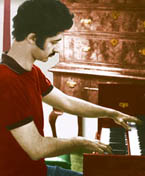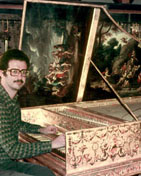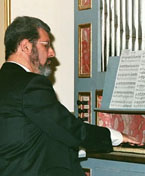The saga of the Hubbard-Di Veroli harpsichord
by Claudio Di Veroli, Copyright © 2008, 2025
Abstract
The Hubbard-Di Veroli harpsichord has been very influential on talented young musicians that are today well-known professional performers and makers, both in South America and in Europe. This webpage tells the remarkable story of this instrument as it was conceived, built and then played for over five decades. See also two separate webpages: Improving an old Hubbard harpsichord kit and Restringing the Hubbard-Di Veroli harpsichord.
From revival harpsichords to the Fenton House
My life as a harpsichord player—and also tuner—began in my native Buenos Aires in 1962. I was then 16, fascinated by the “revival” harpsichords made in Germany by Neupert, Sperrhake and Wittmayer.
Today's young players, who rarely if ever encounter a revival harpsichord, can watch in this YouTube video beginners trying some of them. In times and places where authentic replicas were still not available, these instruments, in spite of their poor, nasal and feeble sound, provided a useful—if limited—window into what was required by early keyboard music. The model I played most often was a small Sperrhake, possibly less bad than others, as shown in this YouTube video. In different occasions I had to play it in public, as late as 1983 as shown in this photo taken during a concert with a small string orchestra.
Having started as a teenager playing these revival contraptions (which do not deserve being named “harpsichords”), later as a student in London in 1968-71 I became acquainted with historical virginals and harpsichords, which I played very often in the Fenton House, Hampstead, as shown in the pictures below.
Bédard and the antique French harpsichords
During those years living in London, I frequently travelled to Paris, where at the Musée Instrumental du Conservatoire (today Musée de la Musique in La Villette) I met and soon befriended the great harpsichord restorer, maker and player, Hubert Bédard. He would generously mentor me in the study of French Baroque music and harpsichords. In countless visits to the Conservatoire, I was given unique permission to practice at length on the 18th-century French double-manual instruments that Bédard and his collaborators had lovingly restored. Playing for hours on end on the Dumont-Taskin, the Collesse (the best looking one), the Goujon (the loudest sounding one) and the golden Ruckers-Taskin (the best sounding one), counts surely as the most amazing musical experience I ever had. See below pictures I took at the time, with permission from the museum, of the Collesse (left) and the Ruckers-Taskin (right).
My main interest has always been the harpsichord music from the High Baroque era c.1650-1750, and it was soon obvious to me that the “double French” was the type of instrument I wished to play for my future musical career. Since I could not afford to buy a ready-made instrument, in my visits to his personal atélier, Bédard kindly showed me how a harpsichord is built and instructed me on building a good-quality harpsichord starting from a “basic kit” by Hubbard (see further below). In the picture below left, I am with Hubert Bédard in his atélier in Boulogne (Paris) in 1971. In the picture on the right, I am playing the golden Ruckers-Taskin in the Paris Conservatoire during my visit of 1975.
Hubbard and his “harpsichord kits”
Once back in my native Argentina after my student years in London, in 1972 I bought a “basic double-French kit” from the late Frank Hubbard, who from Boston (USA) had pioneered the rediscovery of harpsichords based on traditional models. [Hubbard Harpsichords still builds kits and harpsichords under the direction of Hendrik Broekman, and until recently were always reliable suppliers of spare parts like tongues and plectra].
Hubbard wrote in one of his leaflets: “Let me say this about our kits: if the kit is carefully assembled, well voiced and handsomely finished, the result equals the product of any professional maker and resembles its prototype very closely.... ”. Indeed, “the Hubbard kit is not easy to assemble—only a skilled and intelligent worker should undertake it; but when successfully assembled, this kit turns out to be a better instrument than the majority of professionally built harpsichords, a point which was made recently ... by Dr. Wolfgang Schroeder in Das Musikinstrument, Jul. 1968” (W. Zuckermann, The Modern Harpsichord, 1970, p. 133). For many years, in spite of a few differences with respect to the original by Pascal Taskin (Paris 1769), the Hubbard double kit was a regular winner of international harpsichord-kit-making competitions.
By the time Hubbard put together my kit in Boston, shipped it, the kit arrived to Argentina, the customs notified me and I managed—after months of red tape—to get it, it was November 1973! See below on the left the contents of Hubbard's crate—with my now-deceased father Angelo—except for the loosely-assembled case with belly rails and wrestplank, which are shown on the right.
It is worth noting that a double-manual harpsichord is housed in a wooden case that requires very tight tolerances to withstand more than half a tonne of string tension. Many inferior kits are much easier “assemble and glue” affairs, but then they easily undergo deformation and/or implosion as soon as the strings are brought up to pitch. Hubbard's kit was instead a collection of materials carefully selected and mostly reduced to the final thickness, but otherwise left oversized, meant to be finished immediately before assembly. It included accurate Mylar plans and a full Instructions manual.
Assembling the kit, like any harpsichord, meant lots of precision work, such as sawing and sanding every frame until it fitted tightly in place inside the case, cutting the soundboard to shape so that it fitted carefully inside the case, planing nuts and bridges to the required shape, making and installing the strings, and finally assembling and fitting the action jacks. To reduce costs, some parts were not included in the kit and I had them made in Argentina to my own specifications, like the lid, flap, legs, screws, nails, hitchpins (blackened iron for the 8', golden plated for the 4'), jackrail latch, buff batten, handstops and the music desk (see Improving an old Hubbard harpsichord kit, section 3).
The furniture workshop
Building a harpsichord—even when starting from a basic kit—requires a well-equipped workshop and acquaintance with advanced woodworking practices. Luckily, a family friend owned a small factory where they built customised pieces of furniture. They very generously gave me a large space to work and the help of their workers. During the initial assembly of the case, most of the time I read from Hubbard's manual—in English—and told the carpenter—in Spanish—what to do. By the time I was gluing ribs and bridges to the soundboard (see photos below), I had acquired the necessary skills to proceed without help.
I worked on the kit Fridays and Saturday mornings, and had a day job from Monday to Thursday, with plenty of time to mull over any issues. Every time I found a significant difficulty, I would stop, analyse and devise a solution, a few times bothering Frank Hubbard with letters that he always responded with kindness and full details, often engaging in very interesting interchanges (sometimes interesting enough for excerpts of them to be included in papers of mine published decades later). It took several months to complete the instrument as a piece of furniture (see photos below). There was still no painting, no strings and no action.
Painting and stringing
At this stage the instrument was moved to the small apartment where I lived. There a professional painter provided a high-quality modern finish. It was now mid-1974. I then carefully drilled for the 189 hitchpins (compass FF-g''' non-transposing) and more than 400 nut and bridge pins: I did this using a very small hand drill, miraculously managing to get all of them parallel (see photo below left). [No electrical machinery was employed in the assembly of this kit, except for drilling jacks for jack-length screws.] With all the pins in place, the problem was now to determine the stringing schedule.
For this purpose I wrote FORTRAN programs—probably a pioneer use of computers for harpsichord stringing analysis back in 1974—that calculated for each string the tensions and even printed graphs with the “line printers” of the time, as shown above. There are two types of tension: the STRESS and the PULL. The STRESS is internal to the string material, is measured in kilos per square millimetre of diameter and is a function of string length and pitch. If the stress is too low the sound is not good, while if it is too high the string may break: either way, stress is paramount for the choice of the alloy the string is made of. The PULL or LOAD is instead the force of the string against the case, measured in kilos per string, is a function of the same data and also the string diameter or size, and is paramount in the selection of the latter because it determines the sound quality: too high a size makes the sound “dull”, while too low a size makes the string “buzzy”.
I was not happy with the tensions resulting from the generic stringing schedule (dated 1963) suggested by Hubbard for his kit: a most interesting mail interchange with Frank Hubbard ensued, and eventually he approved both my methods and my final stringing schedule, which differed significantly from his, especially in the 8' choirs. Many years later I would eventually find that the pulls from my schedule are very similar to the ones obtained in Taskin's antique harpsichord when his own schedules—which he inscribed in the wrestplank—are followed (see TASKIN HARPSICHORD SCALINGS AND STRINGINGS REVISITED, see also Improving an old Hubbard harpsichord kit, section 8). By the end of 1974 the stringing operation for my kit was complete.
Assembling the action and voicing
This was the final difficult challenge. I have often seen otherwise excellent instruments failing to perform because of a low-quality unreliable action. I was determined instead to have the very best instrument one could possibly build from a Hubbard kit. To achieve this, as we have seen above, lots of precision work were required.
Screws were very expensive in the 18th century and were virtually absent from harpsichord making, but Hubbard used modern screws in his kit to help attach solidly the 8' hitchpin rail and the wrestplank, and also elsewhere, notably in the bottom of the jacks making it easier to regulate their length. These screws, although unhistorical, are convenient for assembly and regulation, and cannot affect either the sound or the action's functionality in any possible way (see however Improving an old Hubbard harpsichord kit, section 11).
The German-made keyboards provided by Hubbard at the time were quite irregular. The spacings in the back could be off by up to one millimetre: I also found that the black Delrin jacks had a very slight but varying curvature by up to a millimetre, so the solution was to fit the jack deviations to the key deviations. The keys were—unhistorically—balanced with lead weights: I removed some (see Improving an old Hubbard harpsichord kit, section 4). I then painstakingly learned to undercut Delrin plectra (provided with a uniform thickness) to provide the necessary taper: only three broke during the first three decades of use. Finally, for every note the jacks were adjusted for a very careful “staggering”: this allowed “voicing” the instrument relatively loud, yet avoiding a heavy action.
Two additions to the stop action provided the additional flexibility needed when playing, with the same instrument, pieces originally meant for very different models. One addition is a “piano stop” lever for the front/upper 8' register (see Improving an old Hubbard harpsichord kit, section 6). The other addition to the usual French disposition consists in the buff batten being provided with two rows of leather pads, acting on either 8' string choir and providing different effects (see Improving an old Hubbard harpsichord kit, section 9).
Recitals and reviews
The sound of the Hubbard-Di Veroli harpsichord, finished in March 1975, was astounding. In April I visited Hubert Bédard in Paris and showed him several photos: he said “I cannot tell how it sounds, but this is surely one of the most carefully-built double French harpsichords I have ever seen.” Back in Buenos Aires, the instrument was premiered in May 1975 (not much time for practice!), and luckily the recital was recorded. This was the first harpsichord based on traditional models ever heard in Argentina: it caused a strong impression and very soon local harpsichordists started ordering similar instruments from abroad. Six years later, after I played it in Buenos Aires at the National Museum of Decorative Arts in 1981, at a time when there were already other similar instruments in the country (some of them built by reputable European makers), in one of the most important newspapers in the country, a reviewer declared that this was the best-sounding harpsichord in all Latin America. In the 1980's and 1990's the Hubbard-Di Veroli harpsichord featured extensively in public performances, mostly in solo recitals but also playing with period-instrument ensembles.
The photo above left shows the instrument at the time of its inauguration in 1975. The photo above right was taken in 1985 in Buenos Aires in the large Teatro Coliseo during the Bach-Handel-Scarlatti Tercentenary Harpsichord Recital, with an audience of over a thousand. This and a few other recitals were recorded, and we have now completed the process of producing movies and uploading them to YouTube, where they can be found searching for Di Veroli harpsichord.
Concert reviewers and colleagues never cease to praise the sound quality of the instrument. It was built for an even and singing sound throughout its range, and this is still one of its characteristics: the action also feels very even and reliable.
Ireland
Carefully packed by my son Rafael, the Hubbard-Di Veroli harpsichord survived intact our removal to the Rep. of Ireland in 2001.
The Hubbard-Di Veroli was used with success in public recitals in Ireland. See above on the left the lovely seafront of Bray (a few kilometres south of Dublin) where we lived, and on the right a picture taken not far from there, during a recital in The Mermaid, The Wicklow's Arts Centre. This harpsichord was held as one of the finest-sounding instruments in the whole country. In 2014 we moved to Lucca, Italy, where the instrument is always in perfect working order and occasionally used in recitals. This harpsichord very rarely goes out of regulation and seldom if ever needs replacement of plectra, dampers or strings.




